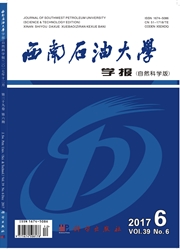

 中文摘要:
中文摘要:
在高温条件下研究了表面活性剂SDBS和NPSS-10与Na+和Ca2+的静电作用机理:(1)SDBS浓度大于临界胶柬浓度(cmc)时Na+作用较弱,Na+与胶束中的阴离子头基形成了离子对,屏蔽了离子头基的静电排斥力,在一定程度上降低了表面活性剂离子头基的极性,活性剂分子排列更加紧密。(2)NPSS10浓度大于cmc时与Na+的作用较强,水化的氧乙烯基高温下部分失水和Na+与胶束中的阴离子头基形成了离子对的共同作用促使表面活性剂的极性降低,抗盐性能增加。(3)在Ca2+浓度较低时,SDBS与钙离子没有相互作用,无沉淀产生,原因是生成的烷基磺酸钙盐有一定的溶解度;在Ca2+浓度较高时,SDBS与Ca2+有强相互作用,电极电位发生显著变化,产生烷基磺酸钙盐沉淀。(4)在低浓度Ca2+溶液中,NPSS-10与Ca2+有较强的作用,无沉淀产生,NPSS-10中的氧乙烯基团与Ca2+形成络合物。在高浓度Ca2+溶液中,NPSS-10与Ca2+没有作用,这是因为NPSS-10在高Ca2+溶液中的极性减弱,再加上空间效应,使得磺酸基头与Ca2+的相互作用减小,形成离子对的能力减弱,避免了Ca2+与磺酸基头的作用产生沉淀,从而使它具有很强的抗Ca2+能力。
 英文摘要:
英文摘要:
Interaction mechanism of SDBS surfactants and NPSS-10 surfactants with sodium ion and calcium ion is studied by potential titration method in high temperature. ( 1 ) SDBS interactes weakly with sodium ion, since ion-pair is formed by the interaction of sodium ion and anionic head groups of SDBS in micelle, which shields static electricity of anionic head groups and decrease the polar of surfactants in certain extent. (2) NPS S-10 interact more strongly with sodium ion when the concentration is over cmc, because EO groups which hydrated dehydrates in high temperature and ion-pair is formed by the interaction of sodium ion and anionic head groups of NPSS-10 in micelle, which decreases polar of the surfactant and increases anti-salinity ability. (3) SDBS has no interaction with calcium ion and does not form chemical precipitation in solution containing low concentration calcium ion, but in high concentration calcium ion solution. SDBS has strong interact with calcium ion and brings about chemical precipitation (alkylphenol sulphonate). (4) NPSS-10 has strong interaction with calcium ion and has no chemical precipitation in low concentration calcium ion solution, because a complex is formed by interaction of EO groups in NPSS-10 molecular with calcium ion. NPSS-10 has no interaction with calcium ion and has no chemical precipitation in high concentration calcium ion solution, because the polar ofNPSS-10 not only decreases, but also static effects decrease interaction of sulfnonate head groups and calcium ion so ion-pair is formed difficultly, and avoids bringing about the chemical precipitation from interaction of calcium ion and sulfonate head groups. NPSS-10 has stronger ability of resist calcium ion.
 同期刊论文项目
同期刊论文项目
 同项目期刊论文
同项目期刊论文
 Synthesis of Bis[N,N-(alkylamideethyl)ethyl] Triethylenediamine Bromide Surfactants and Their Oilfie
Synthesis of Bis[N,N-(alkylamideethyl)ethyl] Triethylenediamine Bromide Surfactants and Their Oilfie Synthesis and Characterization of Novel Surfactants 1,2,3-tri(2-oxypropylsulfonate-3-alkylether-prop
Synthesis and Characterization of Novel Surfactants 1,2,3-tri(2-oxypropylsulfonate-3-alkylether-prop Research on Surfactant Flooding in High-temperature and High-salinity Reservoir for Enhanced Oil Rec
Research on Surfactant Flooding in High-temperature and High-salinity Reservoir for Enhanced Oil Rec 期刊信息
期刊信息
